Source: CIS-77 Home
http://www.c-jump.com/CIS77/CIS77syllabus.htm
Encoding x86 Instructions
- It is time to take a look that the actual machine instruction format of the
x86 CPU family.
- They don't call the x86 CPU a Complex Instruction Set Computer (CISC) for
nothing!
- Although more complex instruction encodings exist, no one is going to
challenge that the x86 has a complex instruction encoding!
1. x86 Instructions Overview
x86 Instruction Encoding:
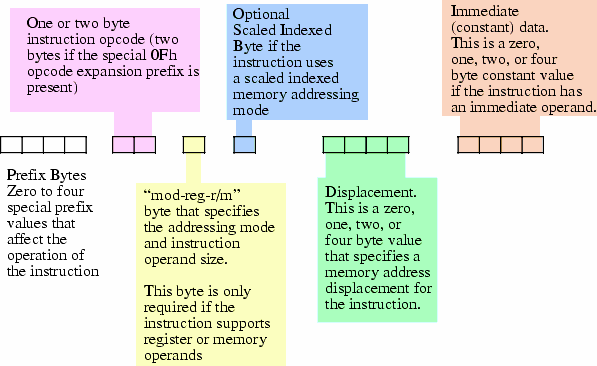
The prefix bytes are not the opcode expansion
prefix discussed earlier - they are special bytes to modify the
behavior of existing instructions.
2. x86 Instruction Format Reference
Another view of the x86 instruction format:
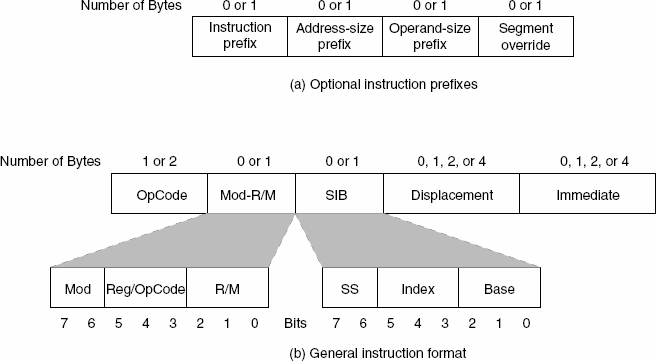
3. x86 Opcode Sizes
The x86 CPU supports two basic opcode sizes:
- standard one-byte opcode
- two-byte opcode consisting of a
0Fh opcode expansion prefix byte.
The second byte then specifies the actual instruction.
- The x86 opcode bytes are 8-bit equivalents of iii field
that we discussed in simplified encoding.
- This provides for up to 512 different instruction classes, although the x86
does not yet use them all.
3.1. x86 ADD Instruction Opcode
x86 ADD
instruction opcode:
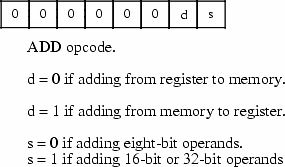
Bit number one, marked d, specifies
the direction of the data transfer:
- If d = 0 then the destination operand is a memory
location, e.g.
add [ebx], al
- If d = 1 then the destination operand is a
register, e.g.
add al, [ebx]
- If s = 0 then the operands are 8-bit registers and
memory locations.
- If s = 1 then the operands are either 16-bits or
32-bits:
- Under 32-bit operating systems the default is 32-bit operands if
s = 1.
- To specify a 16-bit operand (under Windows or Linux) you must
insert a special operand-size prefix byte in front of the
instruction (example of this later.)
You'll soon see that this direction bit d creates a
problem that results in one instruction have two different possible
opcodes.
4. Encoding x86 Instruction Operands, MOD-REG-R/M Byte
The MOD-REG-R/M byte specifies instruction
operands and their addressing mode(*):

The MOD field specifies x86 addressing mode:
| MOD | Meaning
|
|---|
| 00 | Register indirect addressing mode or SIB with no displacement
(when R/M = 100) or Displacement only addressing mode (when R/M = 101).
|
| 01 | One-byte signed displacement follows addressing mode byte(s).
|
| 10 | Four-byte signed displacement follows addressing mode byte(s).
|
| 11 | Register addressing mode.
|
The REG field specifies source or destination
register:
| REG Value
| Register if data size is eight bits
| Register if data size is 16-bits
| Register if data size is 32 bits
|
|---|
| 000 | al | ax | eax
|
| 001 | cl | cx | ecx
|
| 010 | dl | dx | edx
|
| 011 | bl | bx | ebx
|
| 100 | ah | sp | esp
|
| 101 | ch | bp | ebp
|
| 110 | dh | si | esi
|
| 111 | bh | di | edi
|
The R/M field, combined with MOD,
specifies either
- the second operand in a two-operand instruction, or
- the only operand in a single-operand instruction
like NOT or NEG.
The d bit in the opcode determines which operand is
the source, and which is the destination:
- d=0: MOD R/M <- REG, REG is the source
- d=1: REG <- MOD R/M, REG is the destination
(*) Technically, registers do not have an
address, but we apply the term addressing mode to registers
nonetheless.
5. General-Purpose Registers
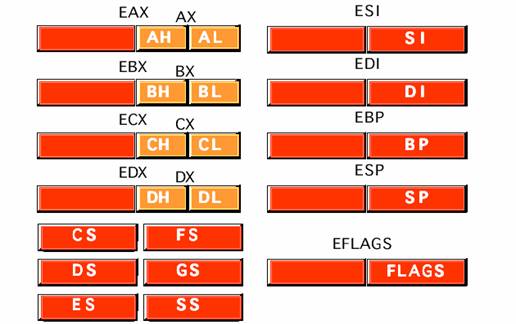
Since the processor accesses registers more quickly than it accesses
memory, you can make your programs run faster by keeping the
most-frequently used data in registers.
- The EAX, EDX, ECX,
EBX, EBP, EDI,
and ESI registers are 32-bit
general-purpose registers, used for temporary data storage and memory
access.
- The AX, DX, CX,
BX, BP, DI, and
SI registers are 16-bit equivalents of
the above, they represent the low-order 16 bits of 32-bit registers.
- The AH, DH, CH, and
BH registers represent the high-order 8
bits of the corresponding registers.
- Similarly, AL, DL, CL, and BL represent the low-order 8 bits of the registers.
6. REG Field of the MOD-REG-R/M Byte
See MOD-REG-R/M Byte.
Depending on the instruction,
this can be either the source or the destination operand.
Many instructions have the d (direction) field in
their opcode to choose REG operand role:
- If d=0, REG is the source,
MOD R/M <- REG.
- If d=1, REG is the destination,
REG <- MOD R/M.
(*) For certain (often single-operand or
immediate-operand) instructions, the REG field may contain an
opcode extension rather than the register bits. The
R/M field will specify the operand in such case.
9. MOD R/M Byte and Addressing Modes
MOD R/M Addressing Mode
=== === ================================
00 000 [ eax ]
01 000 [ eax + disp8 ] (1)
10 000 [ eax + disp32 ]
11 000 register ( al / ax / eax ) (2)
00 001 [ ecx ]
01 001 [ ecx + disp8 ]
10 001 [ ecx + disp32 ]
11 001 register ( cl / cx / ecx )
00 010 [ edx ]
01 010 [ edx + disp8 ]
10 010 [ edx + disp32 ]
11 010 register ( dl / dx / edx )
00 011 [ ebx ]
01 011 [ ebx + disp8 ]
10 011 [ ebx + disp32 ]
11 011 register ( bl / bx / ebx )
00 100 SIB Mode (3)
01 100 SIB + disp8 Mode
10 100 SIB + disp32 Mode
11 100 register ( ah / sp / esp )
00 101 32-bit Displacement-Only Mode (4)
01 101 [ ebp + disp8 ]
10 101 [ ebp + disp32 ]
11 101 register ( ch / bp / ebp )
00 110 [ esi ]
01 110 [ esi + disp8 ]
10 110 [ esi + disp32 ]
11 110 register ( dh / si / esi )
00 111 [ edi ]
01 111 [ edi + disp8 ]
10 111 [ edi + disp32 ]
11 111 register ( bh / di / edi )
- Addressing modes with 8-bit displacement fall in the range -128..+127
and require only a single byte displacement after the opcode (Faster!)
- The size bit in the opcode specifies 8 or 32-bit register size.
To select a 16-bit register requires a prefix byte.
- The so-called scaled indexed addressing modes, SIB =
scaled index byte mode.
- Note that there is no [ ebp ] addressing.
It's slot is occupied by the 32-bit displacement only addressing mode.
Intel decided that programmers can use [ ebp+ disp8 ]
addressing mode instead, with its 8-bit displacement set equal to zero
(instruction is a little longer, though.)
| |
8. SIB (Scaled Index Byte) Layout
Scaled index byte layout:

| Scale Value | Index*Scale Value
|
|---|
| 00 | Index*1
| | 01 | Index*2
| | 10 | Index*4
| | 11 | Index*8
|
|
| Index | Register
|
|---|
| 000 | EAX
| | 001 | ECX
| | 010 | EDX
| | 011 | EBX
| | 100 | Illegal
| | 101 | EBP
| | 110 | ESI
| | 111 | EDI
|
|
| Base | MOD | Register
|
|---|
| 000 | xx | EAX
| | 001 | xx | ECX
| | 010 | xx | EDX
| | 011 | xx | EBX
| | 100 | xx | ESP
| | 101 | 00 | Displacement-only
| | 01, 10 | EBP
| | 110 | xx | ESI
| | 111 | xx | EDI
|
|
- Scaled indexed addressing mode uses the second byte (namely,
SIB byte) that follows the MOD-REG-R/M
byte in the instruction format.
- The MOD field still specifies the displacement size
of zero, one, or four
bytes.
- The MOD-REG-R/M and SIB bytes are complex, because
Intel reused 16-bit addressing circuitry in the 32-bit mode, rather
than simply abandoning the 16-bit format in the 32-bit mode.
- There are good hardware reasons for this, but the end result is a
complex scheme for specifying addressing modes in the opcodes.
8.1. Scaled Indexed Addressing Mode
[ reg32 + eax*n ] MOD = 00
[ reg32 + ebx*n ]
[ reg32 + ecx*n ]
[ reg32 + edx*n ]
[ reg32 + ebp*n ]
[ reg32 + esi*n ]
[ reg32 + edi*n ]
[ disp + reg8 + eax*n ] MOD = 01
[ disp + reg8 + ebx*n ]
[ disp + reg8 + ecx*n ]
[ disp + reg8 + edx*n ]
[ disp + reg8 + ebp*n ]
[ disp + reg8 + esi*n ]
[ disp + reg8 + edi*n ]
[ disp + reg32 + eax*n ] MOD = 10
[ disp + reg32 + ebx*n ]
[ disp + reg32 + ecx*n ]
[ disp + reg32 + edx*n ]
[ disp + reg32 + ebp*n ]
[ disp + reg32 + esi*n ]
[ disp + reg32 + edi*n ]
[ disp + eax*n ] MOD = 00, and
[ disp + ebx*n ] BASE field = 101
[ disp + ecx*n ]
[ disp + edx*n ]
[ disp + ebp*n ]
[ disp + esi*n ]
[ disp + edi*n ]
|
Note: n = 1, 2,
4, or 8.
In each scaled indexed addressing mode the
MOD field in MOD-REG-R/M byte
specifies the size of the displacement. It can be zero, one, or
four bytes:
MOD R/M Addressing Mode
--- --- ---------------------------
00 100 SIB
01 100 SIB + disp8
10 100 SIB + disp32
The Base and Index fields of the SIB
byte select the base and index registers, respectively.
Note that this addressing mode does not allow the use of the
ESP register as an index register. Presumably, Intel
left this particular mode undefined to provide the ability to extend the
addressing modes in a future version of the CPU.
| |
9. Examples
9.1. Encoding ADD Instruction Example
-
The ADD opcode can
be decimal 0, 1, 2, or 3, depending on the direction and size bits in the
opcode:
-
How could we encode various forms of the ADD instruction using different addressing modes?
9.2 Encoding ADD CL, AL Instruction
-
Interesting side effect of the direction bit and the MOD-REG-R/M
byte organization: some instructions can have two different opcodes,
and both are legal!
-
For example, encoding of
add cl, al
could be 00 C1 (if d=0), or 02
C8, if d bit is set to 1.
-
The possibility of opcode duality issue here applies to all instructions
with two register operands.
9.3. Encoding ADD ECX, EAX Instruction
9.4. Encoding ADD EDX, DISPLACEMENT Instruction
9.5. Encoding ADD EDI, [EBX] Instruction
9.6. Encoding ADD EAX, [ ESI + disp8 ] Instruction
9.7. Encoding ADD EBX, [ EBP + disp32 ] Instruction
-
Encoding the ADD EBX, [
EBP + disp32 ] instruction:
add ebx, [ ebp + disp32 ]
![Encoding the ADD EBX, [ EBP + disp32 ] Instruction](encoding_add_ebx_ebp_disp32.png)
9.8. Encoding ADD EBP, [ disp32 + EAX*1 ] Instruction
-
Encoding the ADD EBP, [
disp32 + EAX*1 ] Instruction
add ebp, [ disp32 + eax*1 ]
![Encoding the ADD EBP, [ disp32 + EAX*1 ] Instruction](encoding_add_ebp_disp32_eax_1.png)
9.9. Encoding ADD ECX, [ EBX + EDI*4 ] Instruction
10. Encoding ADD Immediate Instruction
Encoding x86 immediate operands:
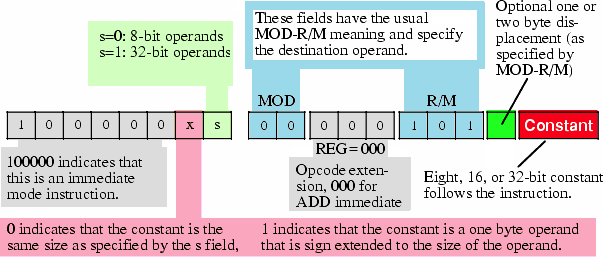
Instead, x86 uses a entirely different instruction format to specify instruction with an immediate operand.
There are three rules that apply:
- If opcode high-order bit set to 1, then instruction
has an immediate constant.
- There is no direction bit in the opcode:
- : indeed, you cannot specify a constant as a destination operand!
- Therefore, destination operand is always the location encoded in the
MOD-R/M bits of the the MOD-REG-R/M byte.
- In place of the direction bit d, the opcode has a sign
extension x bit instead:
- For 8-bit operands, the CPU ignores x bit.
- For 16-bit and 32-bit operands, x bit specifies the
size of the Constant following at
the end of the instruction:
- If x bit contains zero, the Constant is the same
size as the operand (i.e., 16 or 32 bits).
- If x bit contains one, the Constant is a signed 8-bit value, and the CPU sign-extends
this value to the appropriate size before adding it to the operand.
- This little x trick often makes programs shorter,
because adding small-value constants to 16 or 32 bit operands is very
common.
- The third difference between the ADD-immediate and the standard ADD instruction is the meaning of the
REG field in the MOD-REG-R/M byte:
- Since the instruction implies that
- the source operand is a constant, and
- MOD-R/M fields specify the destination operand,
the instruction does not need to use the REG field to
specify an operand.
- Instead, the x86 CPU uses these three bits as an opcode
extension.
- For the ADD-immediate instruction the
REG bits must contain zero.
- Other bit patterns would correspond to a different instruction.
Note that when adding a constant to a memory location, the displacement (if
any) immediately precedes the immediate (constant) value in the opcode
sequence.
11. Encoding Eight, Sixteen, and Thirty-Two Bit Operands
x86 ADD Opcode:

- When Intel designed the 8086, one bit in the opcode,
s, selected between 8 and 16 bit integer operand sizes.
- Later, when CPU added 32-bit integers to its architecture on 80386
chip, there was a problem:
- three encodings were needed to support 8, 16, and 32 bit sizes.
- Solution was an operand size prefix byte.
- Intel studied x86 instruction set and came to the conclusion:
- in a 32-bit environment, programs were more likely to use 8-bit and
32-bit operands far more often than 16-bit operands.
- So Intel decided to let the size bit s in the opcode
select between 8- and 32-bit operands.
11.1. Encoding Sixteen Bit Operands
x86 instruction format:

To allow for 16-bit operands, Intel added prefix a 32-bit mode
instruction with the operand size prefix byte with value
66h.
This prefix byte tells the CPU to operand on 16-bit data rather than
32-bit data.
12. x86 Instruction Prefix Bytes
- x86 instruction can have up to 4 prefixes.
- Each prefix adjusts interpretation of the opcode:
- Repeat/lock prefix byte guarantees that instruction will
have exclusive use of all shared memory, until the instruction completes
execution:
F0h = LOCK
- String manipulation instruction prefixes
F3h = REP, REPE
F2h = REPNE
where
- REP repeats instruction the number of
times specified by iteration count ECX.
- REPE and REPNE prefixes allow to terminate loop on the
value of ZF CPU flag.
Related string manipulation instructions are:
- MOVS, move string
- STOS, store string
- SCAS, scan string
- CMPS, compare string, etc.
See also string manipulation sample program: rep_movsb.asm
- Segment override prefix causes memory access to use
specified segment instead of default segment designated
for instruction operand.
2Eh = CS
36h = SS
3Eh = DS
26h = ES
64h = FS
65h = GS
- Operand override, 66h. Changes size of
data expected by default mode of the instruction e.g. 16-bit to 32-bit and
vice versa.
- Address override, 67h. Changes size of
address expected by the instruction. 32-bit address could switch to 16-bit
and vice versa.
13. Alternate Encodings for Instructions
- To shorten program code, Intel created alternate (shorter) encodings of
some very commonly used instructions.
- For example, x86 provides a single byte opcode for
add al, constant ; one-byte opcode and no MOD-REG-R/M byte
add eax, constant ; one-byte opcode and no MOD-REG-R/M byte
the opcodes are 04h and 05h,
respectively. Also,
- These instructions are one byte shorter than their standard
ADD immediate counterparts.
- Note that
add ax, constant ; operand size prefix byte + one-byte opcode, no MOD-REG-R/M byte
requires an operand size prefix just as a standard ADD AX, constant
instruction, yet is still one byte shorter than the corresponding standard
version of ADD immediate.
- Any decent assembler will automatically choose the shortest
possible instruction when translating program into machine code.
- Intel only provides alternate encodings only for the accumulator registers
AL, AX, EAX.
- This is a good reason to use accumulator registers if you have a choice
(also a good reason to take some time and study encodings of the x86
instructions.)
14. x86 Opcode Summary
- x86 opcodes are represented by one or two bytes.
- Opcode could extend into unused bits of MOD-REG-R/M byte.
- Opcode encodes information about
- operation type,
- operands,
- size of each operand, including the size of an immediate operand.
14.1. MOD-REG-R/M Byte Summary
MOD-REG-R/M Byte:

- MOD-REG-R/M byte follows one or two opcode bytes of
the instruction
- It provides addressing mode information for one or two
operands.
- If operand is in memory, or operand is a
register:
- MOD field (bits [7:6]), combined with the
R/M field (bits [2:0]), specify memory/register
operand, as well as its addressing mode.
- REG field (bits [5:3]) specifies another register operand in of the two-operand
instruction.
15. ISA Design Considerations
- Instruction set architecture design that can stand the test of time is a
true intellectual challenge.
- It takes several compromises between space and efficiency to assign opcodes
and encode instruction formats.
- Today people are using Intel x86 instruction set for purposes never
intended by original designers.
- Extending the CPU is a very difficult task.
- The instruction set can become extremely complex.
- If x86 CPU was designed from scratch today, it would have a
totally different ISA!
- Software developers usually don't have a problem adapting to a new
architecture when writing new software...
...but they are very resistant to moving existing software from one
platform to another.
- This is the primary reason the Intel x86 platform remains so popular to
this day.
15.1. ISA Design Challenges
- Allowing for future expansion of the chip requires some undefined
opcodes.
- From the beginning there should be a balance between the number of
undefined opcodes and
- the number of initial instructions, and
- the size of your opcodes (including special assignments.)
- Hard decisions:
- Reduce the number of instructions in the initial instruction set?
- Increase the size of the opcode?
- Rely on an opcode prefix byte(s), which makes later added instructions
longer?
- There are no easy answers to these challenges for CPU designers!
16. Intel Architecture Software Developer's Manual
Classic Intel Pentium II Architecture Software Developer's Manual contains
three parts:
- Volume 1 , Intel Basic Architecture:
Order Number 243190 , PDF, 2.6 MB.
- Volume 2 , Instruction Set Reference:
Order Number 243191 , PDF, 6.6 MB.
- Volume 3 , System Programing Guide:
Order Number 243192 , PDF, 5.1 MB.
It is highly recommended that you download the above manuals and use them
as a reference.
16.1. Intel Instruction Set Reference (Volume2)
- Chapter 3 of the
Instruction Set Reference describes
- each Intel instruction in detail
- algorithmic description of each operation
- effect on flags
- operand(s), their sizes and attributes
- CPU exceptions that may be generated.
- The instructions are arranged in alphabetical order.
- Appendix A provides opcode map for the entire
Intel Architecture instruction set.
16.2. Chapter 3 of Intel Instruction Set Reference
- Chapter 3 begins with instruction format example and
explains the Opcode column encoding.
- The Opcode column gives the complete machine
codes as it is understood by the CPU.
- When possible, the actual machine code bytes are given as exact
hexadecimal bytes, in the same order in which they appear in memory.
- However, there are opcode definitions other than hexadecimal bytes...
16.3. Intel Reference Opcode Bytes
- Fow example,
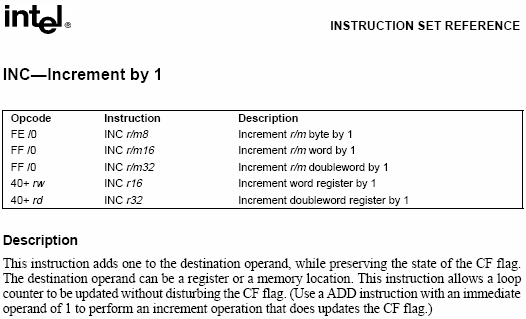
16.4. Intel Reference Opcode Bytes, Cont.
16.5. Intel Reference Opcode Bytes, Cont.
- /r - Indicates that the instruction uses the Mod
R/M byte of the instruction.
- Mod R/M byte contains both
- a register operand reg and
- an r/m (register or memory) operand.
16.6. Intel Reference Opcode Bytes, Cont.
- cb, cw, cd, cp - A 1-byte (cb), 2-byte (cw), 4-byte (cd), or
6-byte (cp) value,
following the opcode, is used to specify
- a code offset,
- and possibly a new value for the code segment register CS.
16.7. Intel Reference Opcode Bytes, Cont.
- ib, iw, id - A 1-byte (ib), 2-byte (iw), or 4-byte (id) indicates
presence of the immediate operand in the instruction.
- Typical order of opcode bytes is
- opcode
- Mod R/M byte (optional)
- SIB scale-indexing byte (optional)
- immediate operand.
- The opcode determines if the operand is a signed value.
- All words and doublewords are given with the low-order byte first (little endian).
16.8. Intel Reference Opcode Bytes, Cont.
- +rb, +rw, +rd - A register code, from 0 through 7, added to the
hexadecimal byte given at the left of the plus sign to form a single opcode
byte.
- Register Encodings Associated with the +rb,
+rw, and +rd:
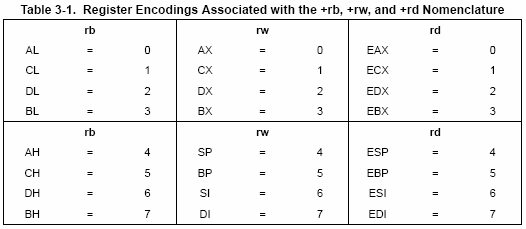
For example,

16.9. Intel Reference Instruction Column
- The Instruction column gives the syntax of the instruction
statement as it would appear in a 386 Assembly program.
- For example,







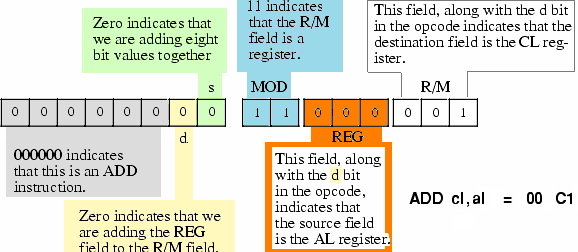
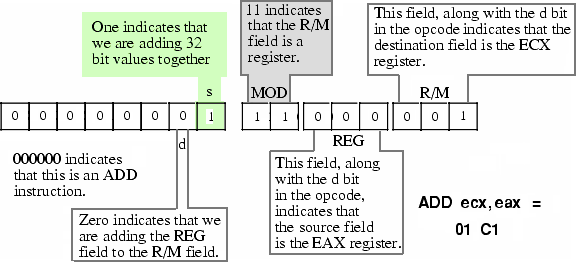
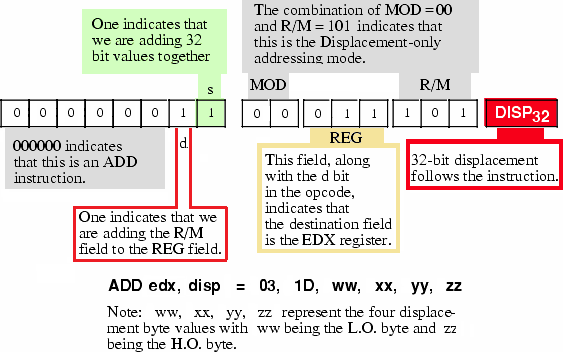
![Encoding the ADD EDI, [EBX] Instruction](encoding_add_edi_ebx.png)
![Encoding the ADD EAX, [ ESI + disp8 ] Instruction](encoding_add_eax_esi_disp8.png)
![Encoding the ADD EBX, [ EBP + disp32 ] Instruction](encoding_add_ebx_ebp_disp32.png)
![Encoding the ADD EBP, [ disp32 + EAX*1 ] Instruction](encoding_add_ebp_disp32_eax_1.png)
![Encoding ADD ECX, [ EBX + EDI*4 ] Instruction](encoding_add_ecx_ebx_edi_4.png)


